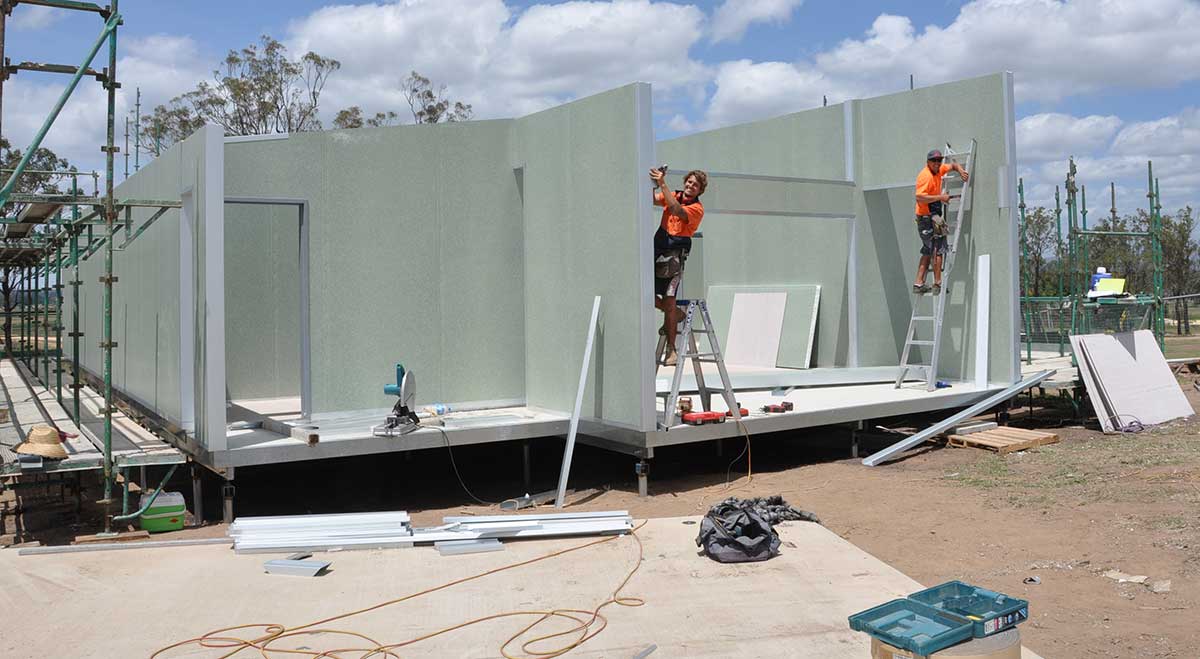As design professionals, LDS has always embraced new and innovative construction technologies and building materials within our architectural designs.
Over twenty years ago we were one of the first in Australia to utilise a revolutionary new air conditioning technology from Europe that applied the heat transfer from an array of multiple vertical rods buried deep in the cooler ground under the basement of mega mansion Chateau de Reves on Sovereign Islands.
This home has been described as futuristic because of the unique roof profile and roofing material used. Often mistakenly referred to as titanium, it is actually constructed using aluminium composite panels, a first residential application at the time.
In more recent years we developed a range of rapid construction flatpack homes utilising EPS composite sandwich panels to construct floors, walls, and roofs.
We won a competition to design several houses to be built in Grantham following the devastating 2011 floods.
The first of these was built in just 5 weeks, allowing a displaced family to be rehoused in a fraction of the time that would normally be required to construct a new home using traditional construction. https://youtu.be/JqcjjKrqoio

We also utilised this innovative construction system to design & build indigenous and other remote housing, temporary mining camp accommodation, central facilities and commercial buildings throughout Australia, and low cost multi residential units and housing in India and Africa.
Applying this flat pack design system to newer composite panel technology, we used modular panels constructed from recycled plastics to design & construct a number of houses in regional Queensland. This technology is now being used worldwide to construct robust housing that can be erected by unskilled labour in remote communities where traditional building materials and skilled trades are scarce.
https://leadesign.com.au/architect/extruded-composite-panel-an-innovative-new-building-system/
In response to the ever-expanding global demand for rapid deployment accommodation, we focussed our architectural design skills to develop an expandable building called Morphouse.TM
Built to the size and specifications of a shipping container to facilitate global transportation, within hours of reaching its destination it transformed into a building 3 times its original size and could be utilised for multiple purposes.
As global warming continues to impact our weather systems resulting in unprecedented natural disasters, the need for temporary emergency shelters has never been greater.
Applying our architectural design knowledge to research the latest technological advances in building materials that could be adapted to this problem, we developed small rapid response shelter pods utilising a very lightweight high strength composite honeycomb panel.
Designed as flatpack kits, this allowed multiple units to be transported on military pallets capable of being dispatched rapidly by road, rail, or air to any remote disaster site.
FEMA in the USA expressed serious interest in utilising this innovative system to link multiple pods together to create small temporary homes that could be erected in the backyards of houses destroyed by Hurricane Katrina while families rebuilt their homes.
In most disaster situations, Governments don’t have the funds available to rapidly house displaced people, especially in third world countries.
In response we began development of an alternative lower cost fully recyclable shelter that could be used in the immediate aftermath of a disaster until more substantial accommodation could be established.
We introduced a major Australian cardboard manufacturer to researchers from QUT who were investigating the use of lignin, a natural by-product of sugar cane to create stronger recyclable and renewable waterproof cardboard, replacing the traditional petrochemical based wax coating.
Cardboard technology has recently been applied to another pressing need in the housing sector for a sustainable alternative to timber and steel stud framing.
With the Covid related global shortage of building materials exacerbated by the current sanctions imposed on Russia, a Swedish company has developed a new innovative product to replace these studs with a lightweight alternative manufactured from wood pulp.
Creative Innovation contributing positively to improving the world we live in.
https://www.archdaily.com/978279/climate-smart-studs-made-of-paper-wood-tube
If you are interested in other advances in materials and construction, you can read this recent article explaining why cross laminated timber (CLT) is being adopted as an alternative to steel and concrete in many new projects. https://leadesign.com.au/architect/clt-the-21st-century-construction-disrupter/
You might also be interested in...
The Most Popular Home Configurations in Australia in 2024
Discover 2024’s top Australian home configurations: bedrooms, bathrooms, and parking preferences. Explore how changing lifestyles shape popular house configurations nationwide.
Exploring Contemporary Applications of Brise Soleil
Contemporary applications of Brise Soleil combine functionality, aesthetics, and sustainability, making them a popular choice in various building designs worldwide.
